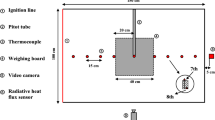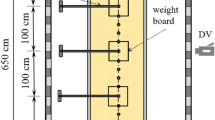Abstract
The slope of ground has a significant impact on the spread and burning process for spill fires on land. In this paper, a series of continuous spill fire experiments were conducted on a fireproof glass sheet with different slope angles (0.5°, 1°, 3°) to study the effects of slope on fuel spread and burning behaviors. The results show that the spread process can be divided into four phases based on time-dependent spread area. The maximum spread area and spread rate both increased greatly with increasing slope angle for a constant discharge rate, while the effect of slope on the steady burning area was only slight. The burning rate in the quasi-steady burning phase tends to be a little lower with increasing slope. It is proved that the burning rate at the quasi-steady burning phase is lower than that of pool fires under the same burning size and the corresponding ratio is close to 0.32, independent on the discharge rate and the slope angle. Then, a simple modification coefficient was introduced and a burning rate model of spill fires was developed, which provide a basis for liquid layer simulation under the burning conditions.






Similar content being viewed by others
References
Li P, Liu J, Chen M, et al. Experimental study of high altitude effect on heat release rates of pool fires using calorimeters. J Therm Anal Calorim. 2018;131(2):1597–603.
Bohl D, Jackson G. Experimental study of the spill and vaporization of a volatile liquid. J Hazard Mater. 2007;140(1):117–28.
Lehr W, Simecek-Beatty D. Comparison of hypothetical LNG and fuel oil fires on water. J Hazard Mater. 2004;107(1):3–9.
Gottuk DT, White DA. Liquid fuel fires. In: Morgan JH, editor. The SFPE handbook of fire protection engineering. Berlin: Springer; 2015.
Drysdale D. An introduction to fire dynamics. In: Diffusion and heat transfer in chemical kinetics plenum. 2011.
Ni ZJ, Wang YZ, Yin ZG. Relative risk model for assessing domino effect in chemical process industry. Saf Sci. 2016;87:156–66.
Zhao JL, Huang H, Wang H, et al. Experimental study on burning behaviors and thermal radiative penetration of thin-layer burning. J Therm Anal Calorim. 2017;130(2):1153–62.
Gottuk D, Scheffey J, Williams F, et al. Optical fire detection for military aircraft hangars: final report on OFD performance to fuel spill fires and optical stresses. Naval Research Laboratory NRL/MR/6180-00-8457, Washington, DC, 2001. p. 1–341.
Mealy C, Benfer M, Gottuk D T. A study of the parameters influencing liquid fuel burning rates. In: 11th Fire safety science symposium. 2011. p. 945–58.
Mealy C, Benfer M, Dan G. Liquid fuel spill fire dynamics. Fire Technol. 2014;50(2):419–36.
Ingason H, Li ZY. Spilled liquid fires in tunnels. Fire Saf J. 2017;91:399–406.
Li YT, Huang H, Wang Z, et al. An experimental and modeling study of continuous liquid fuel spill fires on water. J Loss Prevent Proc. 2015;33:250–7.
Zhao JL, Liu QY, Huang H, et al. Experiments investigating fuel spread behaviors for continuous spill fires on fireproof glass. J Fire Sci. 2017;35(1):80–95.
Li YT, Huang H, Zhang LH, et al. An experimental investigation into the effect of substrate slope on the continuously released liquid fuel spill fires. J Loss Prevent Proc. 2017;52:21–8.
Lei J, Liu NA, Zhang LH, et al. Experimental research on combustion dynamics of medium-scale fire whirl. Proc Combust Inst. 2011;33(2):2407–15.
Liu NA, Liu Q, Lozano JS, et al. Global burning rate of square fire arrays: experimental correlation and interpretation. Proc Combust Inst. 2009;32(2):2519–26.
Su BN, Huang H, Zhang N. Dynamic urban waterlogging risk assessment method based on scenario simulations. J Tsinghua Univ (Sci Technol). 2015;55(6):684–90.
Yen BC. Open channel flow resistance. J Hydraul Eng. 2002;128(1):20–39.
Cozzani V, Gubinelli G, Antonioni G, et al. The assessment of risk caused by domino effect in quantitative area risk analysis. J Hazard Mater. 2005;127(1–3):14–30.
Landucci G, Argenti F, Tugnoli A, et al. Quantitative assessment of safety barrier performance in the prevention of domino scenarios triggered by fire. Reliab Eng Syst Saf. 2015;143:30–43.
Hamins A, Fischer SJ, Kashiwagi T, et al. Heat feedback to the fuel surface in pool fires. Combust Sci Technol. 1994;97(1–3):37–62.
Burgess DS, Strasser A, Grumer J. Diffusive burning of liquids in open trays. Fire Res Abstr Rev. 1961;3:177–92.
Babrauskas V. Estimating large pool fire burning rates. Fire Technol. 1983;19:251–61.
Munoz M, Arnaldos J, Casal J, et al. Analysis of the geometric and radiative characteristics of hydrocarbon pool fires. Combust Flame. 2004;139(3):263–77.
Zhao JL, Huang H, Li YT, et al. Quantitative risk assessment of continuous liquid spill fires based on spread and burning behaviors. Appl Therm Eng. 2017;126:500–6.
Suo-Anttila JM, Blanchat TK, Ricks AJ, et al. Characterization of thermal radiation spectra in 2 m pool fires. Proc Combust Inst. 2009;32(2):2567–74.
Fay JA. Model of spills and fires from LNG and oil tankers. J Hazard Mater. 2003;96(2):171–88.
Johnson DW, Cornwell JB. Modeling the release, spreading, and burning of LNG, LPG, and gasoline on water. J Hazard Mater. 2007;140(3):535–40.
Acknowledgements
This study was sponsored by the National Key R&D Program of China National Key R&D Program of China(2018YFC0808100)and the National Natural Science Foundation of China (Grant Nos. U1633203, U1733126, 51874313, 51906253).
Author information
Authors and Affiliations
Corresponding author
Additional information
Publisher's Note
Springer Nature remains neutral with regard to jurisdictional claims in published maps and institutional affiliations.
Rights and permissions
About this article
Cite this article
Liu, Q., Zhao, J., Lv, Z. et al. Experimental study on the effect of substrate slope on continuously released heptane spill fires. J Therm Anal Calorim 140, 2497–2503 (2020). https://doi.org/10.1007/s10973-019-08998-9
Received:
Accepted:
Published:
Issue Date:
DOI: https://doi.org/10.1007/s10973-019-08998-9




